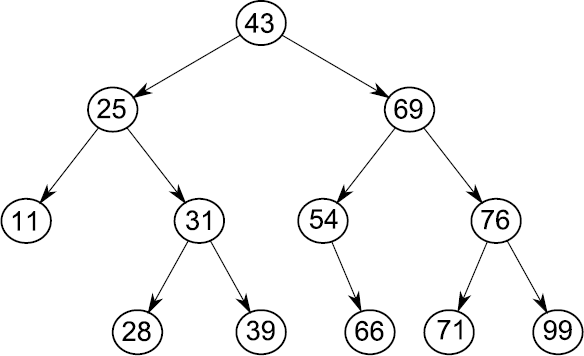Binary search tree: Difference between revisions
Jump to navigation
Jump to search
(→Remark) |
(→Remark) |
||
| Line 27: | Line 27: | ||
== Remark == | == Remark == | ||
* Besides the methods of [[Sorted sequence|sorted sequences]], binary search trees in the implementation chosen here have a private method [[Binary Search Tree:Remove node]], which receives a pointer <math>p</math> to a binary search tree node and removes | * Besides the methods of [[Sorted sequence|sorted sequences]], binary search trees in the implementation chosen here have a private method [[Binary Search Tree:Remove node]], which receives a pointer <math>p</math> to a binary search tree node and removes it (possibly by removing another node and overwriting the key to be removed with the key of the other node. Prerequisite: <math> p</math>.left <math>\neq</math>void. | ||
* There are variants on binary search trees, such as [http://en.wikipedia.org/wiki/AVL_tree AVL trees] and [http://en.wikipedia.org/wiki/Red_black_tree red-black-trees], for which the height of the tree is guaranteed to be in <math>O \log{n}</math> in these variants (because the additional operations in these methods are necessary to maintain logarithmic height are linear in the height of the tree as well. | * There are variants on binary search trees, such as [http://en.wikipedia.org/wiki/AVL_tree AVL trees] and [http://en.wikipedia.org/wiki/Red_black_tree red-black-trees], for which the height of the tree is guaranteed to be in <math>O \log{n}</math> in these variants (because the additional operations in these methods are necessary to maintain logarithmic height are linear in the height of the tree as well. | ||
* The mathematical concept behind this data structure is described in the section on [[Directed Tree#Binary Search Tree|binary search trees]] of page [[Directed Tree]]. | * The mathematical concept behind this data structure is described in the section on [[Directed Tree#Binary Search Tree|binary search trees]] of page [[Directed Tree]]. | ||
Revision as of 14:34, 17 May 2015
General Information
Abstract data structure: Sorted sequence
Implementation invariant:
- There is a tree item type with three components:
- key is of generic type [math]\displaystyle{ \mathcal{K} }[/math],
- left and right of type "pointer to tree item of type [math]\displaystyle{ \mathcal{K} }[/math]."
- An object of the binary search tree type contains a pointer root of type "pointer to tree item of type [math]\displaystyle{ \mathcal{K} }[/math]."
- The pointer root points to a well-formed binary search tree. In accordance with the definition of directed trees, "well-formed" means that, for any node, there is exactly one path from the root to that node.
Remark
- Besides the methods of sorted sequences, binary search trees in the implementation chosen here have a private method Binary Search Tree:Remove node, which receives a pointer [math]\displaystyle{ p }[/math] to a binary search tree node and removes it (possibly by removing another node and overwriting the key to be removed with the key of the other node. Prerequisite: [math]\displaystyle{ p }[/math].left [math]\displaystyle{ \neq }[/math]void.
- There are variants on binary search trees, such as AVL trees and red-black-trees, for which the height of the tree is guaranteed to be in [math]\displaystyle{ O \log{n} }[/math] in these variants (because the additional operations in these methods are necessary to maintain logarithmic height are linear in the height of the tree as well.
- The mathematical concept behind this data structure is described in the section on binary search trees of page Directed Tree.
